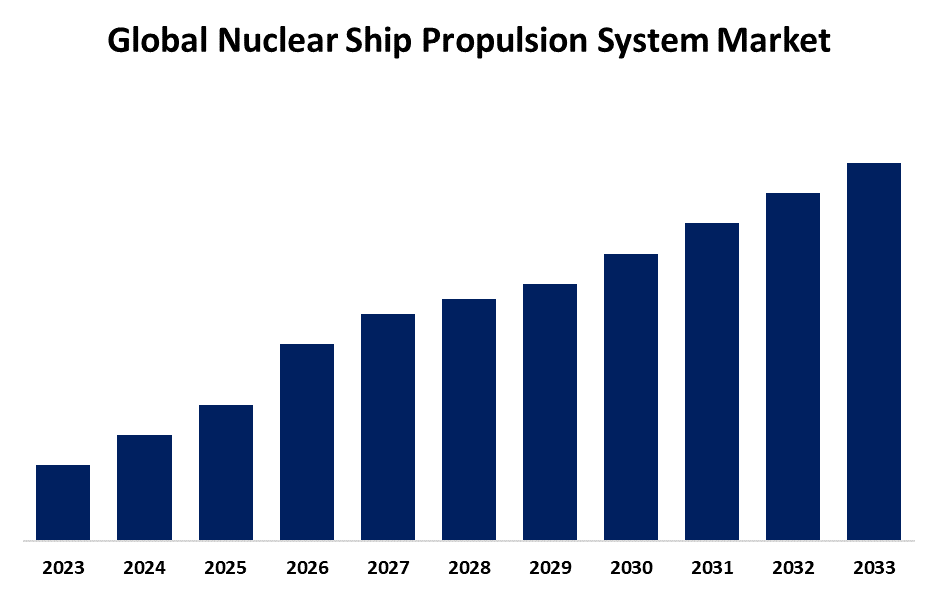Global Nuclear Ship Propulsion System Market Size, Share, and COVID-19 Impact Analysis, By Type (Pressurized Water Reactors (PWRs), Boiling Water Reactors (BWRs), Liquid Metal Fast Reactors (LMFRs), and Others), By Application (Commercial Vessels, Military Vessels, Icebreakers, and Others), and By Region (North America, Europe, Asia Pacific, Latin America, Middle East, and Africa), Analysis and Forecast 2023 - 2033
Industry: Aerospace & DefenseGlobal Nuclear Ship Propulsion System Market Insights Forecasts to 2033
- The Global Nuclear Ship Propulsion System Market Size is Expected to Grow at a CAGR of around XX% from 2023 to 2033
- The Worldwide Nuclear Ship Propulsion System Market Size is Expected to hold a significant share by 2033
- Asia Pacific is Expected to Grow the fastest during the forecast period.

Get more details on this report -
The Global Nuclear Ship Propulsion System Market Size is anticipated to hold a significant share by 2033, Growing at a CAGR of XX% from 2023 to 2033.
Market Overview
The development and use of nuclear-powered propulsion systems for marine vessels are the focus of the nuclear ship propulsion system market. The military's strategic use of nuclear-powered ships is another important factor propelling the market's expansion. Military aircraft powered by nuclear propulsion can travel at high speeds for lengthy periods of time without refueling, offering unparalleled tactical and strategic advantages. The capacity to stay at sea and continue operations for extended periods of time without relying on fuel supply lines is crucial for naval operations, which attracts more interest and investments from the global military industry. Particularly in areas with substantial maritime interests, the demand for nuclear propulsion systems is further supported by the geopolitical environment and the requirement for strong naval capabilities. The growing need for efficient and sustainable propulsion systems that can adhere to strict environmental standards is the main factor propelling this market's expansion. Because nuclear propulsion can provide major advantages including lowering greenhouse gas emissions and increasing operational efficiency for long-distance travel, its use is becoming more and more popular. These benefits are becoming more widely acknowledged in the military and commercial sectors, where there is a constant demand for cutting-edge propulsion technology to overcome the drawbacks of traditional fossil fuel-powered systems.
Report Coverage
This research report categorizes the global nuclear ship propulsion system market based on various segments and regions forecasts revenue growth and analyzes trends in each submarket. The report analyses the key growth drivers, opportunities, and challenges influencing the global nuclear ship propulsion system market. Recent market developments and competitive strategies such as expansion, product launch, and development, partnership, merger, and acquisition have been included to draw the competitive landscape in the market. The report strategically identifies and profiles the key market players and analyses their core competencies in each sub-segment of the global nuclear ship propulsion system market.
Nuclear Ship Propulsion System Market Report Coverage
| Report Coverage | Details |
|---|---|
| Base Year: | 2023 |
| Forecast Period: | 2023-2033 |
| Historical Data for: | 2019-2022 |
| No. of Pages: | 234 |
| Tables, Charts & Figures: | 110 |
| Segments covered: | By Type, By Application |
| Companies covered:: | Rolls-Royce, General Electric, Westinghouse Electric Company, Babcock International Group, BWX Technologies, Huntington Ingalls Industries, China National Nuclear Corporation (CNNC), Rosatom, Areva, Mitsubishi Heavy Industries, Kawasaki Heavy Industries, Hyundai Heavy Industries, and Others. |
| Pitfalls & Challenges: | Covid-19 Empact, Challenges, Growth, Analysis. |
Get more details on this report -
Driving Factors
The market for nuclear ship propulsion systems is expected to develop significantly due to growing environmental sustainability consciousness and the urgent need to lower carbon footprints in marine operations. The industry is forced to investigate alternate propulsion technologies like nuclear energy, which does not produce direct carbon emissions, as a result of tightening international rules, such as the International Maritime Organization's (IMO) decrease of sulfur emissions from ships. Another significant benefit of nuclear propulsion systems is their fuel efficiency, which allows for long-distance travel without the need for frequent recharging. For uses like icebreakers and military ships that operate in isolated areas where refueling logistics are difficult, this becomes very beneficial. Additionally, technological developments and breakthroughs in nuclear reactor designs that improve safety and efficiency are another important driver driving the industry. With the advent of small modular reactors (SMRs) and sophisticated reactor technologies that promise improved safety features and efficient power output, modern nuclear propulsion systems have experienced major advancements. These advancements in technology make nuclear propulsion a competitive alternative to conventional systems, especially for big vessels where dependability and long-term power output are essential. The deployment of these technologies is also being accelerated by the demand from governments and international organizations to invest in nuclear research and development.
Restraints & Challenges
Public perception of nuclear power and regulatory barriers are two of the biggest issues facing the market for nuclear ship propulsion systems. Public opinion and regulatory environments are impacted by ongoing worries about nuclear safety and the possibility of accidents, even in the face of technological breakthroughs and safety enhancements in contemporary nuclear reactors.
Market Segmentation
The global nuclear ship propulsion system market share is classified into type and application.
- The pressurized water reactors segment held a significant share in 2023 and is expected to grow at a significant CAGR during the forecast period.
Based on the type, the global nuclear ship propulsion system market is categorized as pressurized water reactors (PWRs), boiling water reactors (BWRs), liquid metal fast reactors (LMFRs), and others. Among these, the pressurized water reactors segment accounted for a significant share in 2023 and is expected to grow at a significant CAGR during the forecast period. PWRs are the most widely utilized reactors in naval propulsion because of their reliable construction and effective operation. They are perfect for military vessels due to their capacity to continue stable operations in a variety of circumstances.
- The commercial vessels segment held a significant share in 2023 and is expected to grow at a significant CAGR during the forecast period.
Based on the application, the global nuclear ship propulsion system market is categorized as commercial vessels, military vessels, icebreakers, and others. Among these, the commercial vessels segment held a significant share in 2023 and is expected to grow at a significant CAGR during the forecast period. Commercial ships are increasingly investigating nuclear options to improve long-range travel capabilities and lessen environmental effect, even if they are not as common in nuclear propulsion as military ships.
Regional Segment Analysis of the Global nuclear ship propulsion system Market
- North America (U.S., Canada, Mexico)
- Europe (Germany, France, U.K., Italy, Spain, Rest of Europe)
- Asia Pacific (China, Japan, India, Rest of APAC)
- South America (Brazil and the Rest of South America)
- The Middle East and Africa (UAE, South Africa, Rest of MEA)
North America is projected to hold a significant share of the global nuclear ship propulsion system market over the forecast period.

Get more details on this report -
North America is projected to hold a significant share of the global nuclear ship propulsion system market over the forecast period. This region is propelled by significant investments in marine defense and the presence of top inventors in technology. Particularly important is the United States, whose U.S. Navy uses nuclear propulsion technology extensively for its aircraft carriers and submarines. This area enjoys strong government funding and support for nuclear technology research and development, which creates an atmosphere that encourages creativity and progress. With a robust defense budget and strategic ambitions to preserve naval superiority, the North American market is expected to increase gradually.
Asia Pacific is expected to grow at the fastest CAGR growth of the global nuclear ship propulsion system market during the forecast period. The region is driven by rising investments in maritime technologies and the quick growth of commercial shipping operations. Leading the way in adopting cutting-edge propulsion technologies to improve their marine sectors are nations like China, South Korea, and Japan. The market is greatly boosted by China's strategic focus on enhancing its naval capabilities and ensuring energy-efficient marine operations. The region's growth is further bolstered by government programs targeted at lowering carbon emissions and enhancing energy efficiency in maritime operations.
Competitive Analysis:
The report offers the appropriate analysis of the key organizations/companies involved within the global nuclear ship propulsion system market along with a comparative evaluation primarily based on their product offering, business overviews, geographic presence, enterprise strategies, segment market share, and SWOT analysis. The report also provides an elaborative analysis focusing on the current news and developments of the companies, which includes product development, innovations, joint ventures, partnerships, mergers & acquisitions, strategic alliances, and others. This allows for the evaluation of the overall competition within the market.
List of Key Companies
- Rolls-Royce
- General Electric
- Westinghouse Electric Company
- Babcock International Group
- BWX Technologies
- Huntington Ingalls Industries
- China National Nuclear Corporation (CNNC)
- Rosatom
- Areva
- Mitsubishi Heavy Industries
- Kawasaki Heavy Industries
- Hyundai Heavy Industries
- Others
Key Target Audience
- Market Players
- Investors
- End-users
- Government Authorities
- Consulting And Research Firm
- Venture capitalists
- Value-Added Resellers (VARs)
Market Segment
This study forecasts revenue at global, regional, and country levels from 2020 to 2033. Spherical Insights has segmented the global nuclear ship propulsion system market based on the below-mentioned segments:
Global Nuclear Ship Propulsion System Market, By Type
- Pressurized Water Reactors (PWRs)
- Boiling Water Reactors (BWRs)
- Liquid Metal Fast Reactors (LMFRs)
- Others
Global Nuclear Ship Propulsion System Market, By Application
- Commercial Vessels
- Military Vessels
- Icebreakers
- Others
Global Nuclear Ship Propulsion System Market, By Regional
- North America
- US
- Canada
- Mexico
- Europe
- Germany
- UK
- France
- Italy
- Spain
- Russia
- Rest of Europe
- Asia Pacific
- China
- Japan
- India
- South Korea
- Australia
- Rest of Asia Pacific
- South America
- Brazil
- Argentina
- Rest of South America
- Middle East & Africa
- UAE
- Saudi Arabia
- Qatar
- South Africa
- Rest of the Middle East & Africa
Frequently Asked Questions (FAQ)
-
1. What is the CAGR of the global nuclear ship propulsion system market over the forecast period?The Global Nuclear Ship Propulsion System Market Size is Expected to Grow from USD 1.14 Billion in 2023 to USD 2.23 Billion by 2033, at a CAGR of 6.94% during the forecast period 2023-2033.
-
2. Which region is expected to hold the largest share of the global nuclear ship propulsion system market?North America is projected to hold the largest share of the global nuclear ship propulsion system market over the forecast period.
-
3. Who are the top key players in the global nuclear ship propulsion system market?Rolls-Royce, General Electric, Westinghouse Electric Company, Babcock International Group, BWX Technologies, Huntington Ingalls Industries, China National Nuclear Corporation (CNNC), Rosatom, Areva, Mitsubishi Heavy Industries, Kawasaki Heavy Industries, Hyundai Heavy Industries, and others.
Need help to buy this report?